How Far Can a Paramotor Fly? Paramotor Range Explained
30 November 2023 | Updated on January 03, 2024 | 0 comments
Paramotoring, a form of ultralight aviation, offers an exhilarating blend of freedom and simplicity in flight. A key aspect that defines this experience is the range of the paramotor – essentially, how far it can fly on a single fuel load. This range is not just a figure of curiosity but a critical factor that influences flight planning, safety, and the overall scope of adventure possible with a paramotor. In this article, we will explore the various elements that determine a paramotor’s range, offering insights for both aspiring and seasoned pilots to maximize their flying experiences.
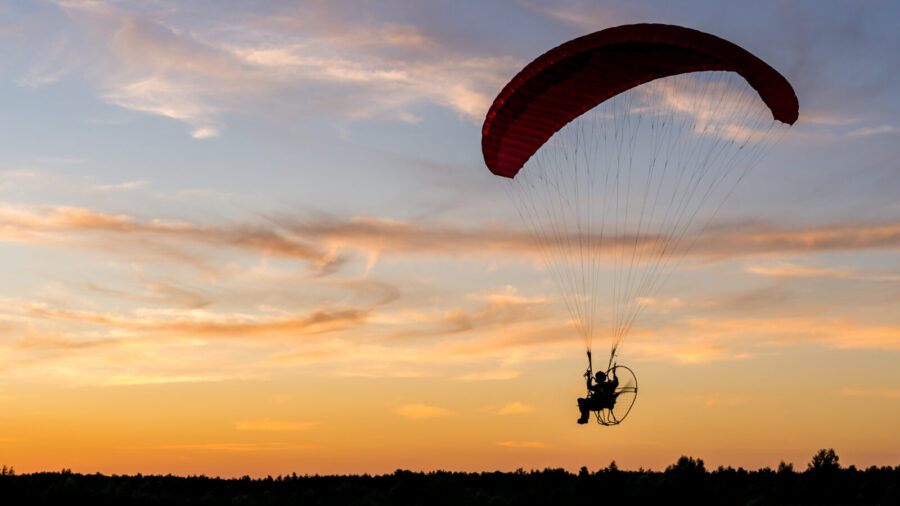
Understanding Paramotor Range
The concept of range in paramotoring is both fascinating and vital for pilots. It refers to the distance a paramotor can travel on a single tank of fuel under specific conditions. This range is influenced by various factors, including the efficiency of the engine, the weight of the pilot and gear, and environmental conditions.
How far can a paramotor fly?
Typically, a paramotor can fly for about 2 to 3 hours on a full tank of fuel. This translates to a range of approximately 50 to 150 kilometers (30 to 90 miles), depending on the specific model and conditions. However, it’s important to note that this is a general estimate. The actual range can vary significantly based on several factors, which we will explore in the following sections.
Calculating the range of a paramotor involves considering:
- Fuel Capacity: The amount of fuel the paramotor can hold is the starting point. Larger fuel tanks offer the potential for longer flights, but also add weight.
- Fuel Consumption: This depends on the engine’s efficiency and the power setting used during the flight. Higher power settings for faster speeds will consume more fuel.
- Flight Conditions: Factors like wind direction, air density, and temperature can affect fuel efficiency and thus the range.
Understanding the range of a paramotor is crucial for effective flight planning and safety. It helps pilots make informed decisions about their flight paths, ensuring they have enough fuel to reach their destination or return safely. In the next sections, we’ll delve deeper into the factors that influence this range and how pilots can maximize it for longer and more enjoyable flights.
Key Factors Influencing Paramotor Range
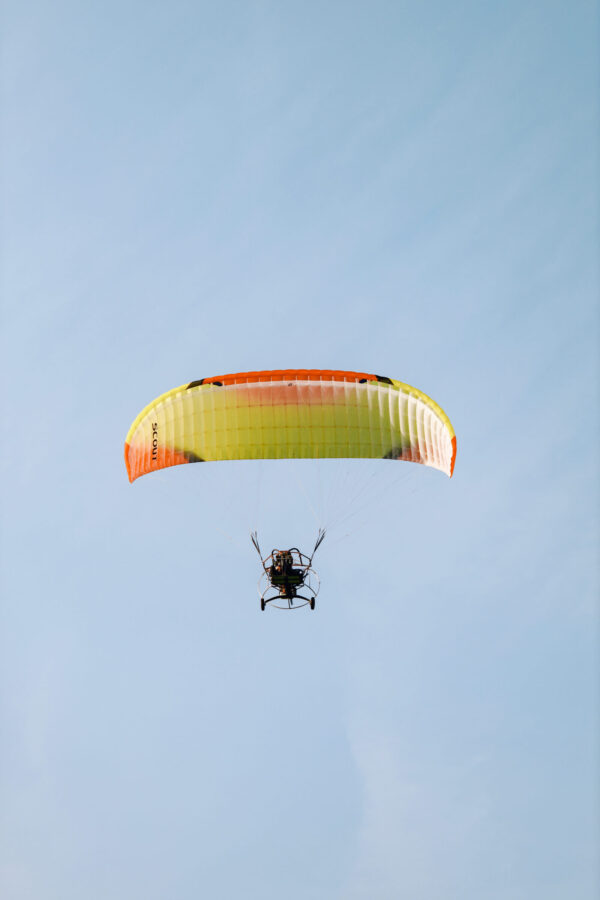
The range of a paramotor is not a static figure; it’s influenced by a variety of factors that can either extend or limit the distance a pilot can fly. Understanding these elements is crucial for maximizing flight potential and ensuring safety.
Fuel Capacity and Engine Efficiency
The size of the paramotor’s fuel tank directly impacts how long it can stay airborne. Larger tanks enable longer flights, but also add weight, which can affect performance.
More efficient engines also consume less fuel for the same power output, extending the range. The type of engine and its tuning play a significant role in determining fuel efficiency.
Pilot Weight and Gear Load
The combined weight of the pilot and any additional gear affects fuel consumption. Heavier loads require more power to stay aloft, thus reducing the range.
Environmental Conditions
The environment and weather will also play a significant role in the potential distance you can cover with a paramotor. Tailwinds can significantly increase a paramotor’s range by pushing it further along its flight path, while headwinds will do the opposite.
Hotter temperatures and lower air density (often found at higher altitudes) can also reduce engine performance and wing lift, impacting the range.
Flight Style and Conditions
Flying at the optimal cruising speed for the paramotor can maximize fuel efficiency. This efficiency can also be improved by using thermals (rising columns of warm air) to gain altitude without using the engine, conservatively extending the flight range. This is the same strategy glider pilots use to stay aloft for many hours at a time, covering distances of up to 1000+ km!
Each of these factors plays a part in determining how far a paramotor can fly on a single tank of fuel. By understanding and managing these elements, pilots can make the most of their flights, exploring further while always keeping safety in mind. Next, we will explore strategies and tips for maximizing your paramotor’s range.
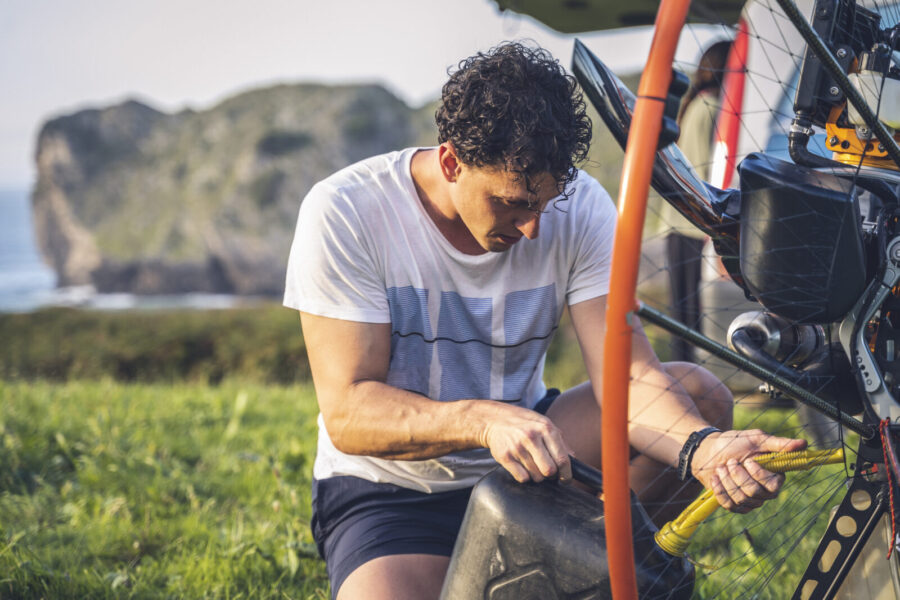
Instructor pilot prepares for a solo flight over the picturesque Asturian coastline.
Maximizing Your Paramotor’s Range
For paramotor enthusiasts, extending the flight range is often a key objective. Achieving this requires a blend of efficient fuel management, strategic flying techniques, and proper equipment maintenance. Here are some strategies and tips to help pilots maximize their paramotor’s range.
Efficient Fuel Management
Understanding and managing fuel consumption is critical. This involves flying at optimal speeds that balance fuel efficiency with desired pace. Pilots should be aware of their engine’s fuel consumption rates at different power settings and plan their flights accordingly. It’s also beneficial to monitor fuel levels regularly during flight to avoid unexpected shortages.
Learn more about the safety considerations of paramotor fuel management:
Strategic Flying Techniques
Utilizing natural elements like wind and thermals can significantly extend a paramotor’s range. Flying with tailwinds, whenever possible, can help cover more distance with less fuel. Additionally, experienced pilots can use thermals to gain altitude without expending much fuel, effectively extending the range.
Equipment and Maintenance for Optimal Range
The condition and type of equipment play a vital role in maximizing range. Regular maintenance of the engine and propeller ensures they are operating at peak efficiency. Pilots should also consider the weight and aerodynamic design of their gear. Lighter and more aerodynamically efficient equipment can reduce fuel consumption, thereby extending the range.
Planning and Preparation
Careful flight planning is essential. This includes mapping out routes that take advantage of favorable wind conditions and considering potential landing spots in case of emergencies. Pilots should also be prepared for changing weather conditions which can affect range.
By combining these strategies, pilots can enhance their paramotor’s range, allowing for longer and more adventurous flights. However, it’s important to always have a margin of safety in terms of fuel and to be prepared for unexpected situations. In the next section, we will discuss the real-world applications of paramotor range and how it plays a role in different flight scenarios.
Conclusion
In paramotoring, understanding and effectively managing the range is as crucial as it is empowering. It’s a key factor that influences not just the distance one can travel, but also the overall safety and enjoyment of the flight. Pilots equipped with knowledge about their paramotor’s range, and who apply strategies to maximize it, can explore the skies with greater confidence and freedom.
However, it’s important to always balance the desire for extended adventures with the practicalities of fuel limits and safety considerations. Responsible flying involves not just pushing boundaries but also recognizing and respecting them. By doing so, paramotor pilots can ensure that each flight is not only exhilarating but also safely within the realm of their machine’s capabilities. In the end, the true essence of paramotoring lies in the joy of flight within the bounds of safety and practicality, making every journey in the sky an adventure to cherish.
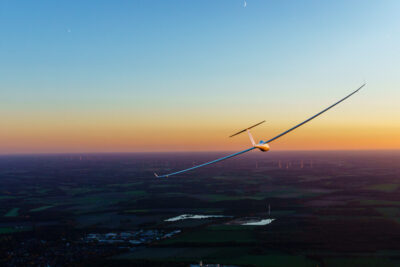
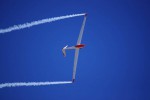
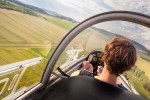

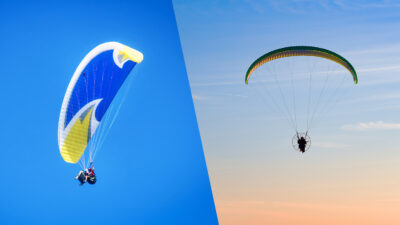

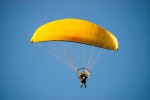
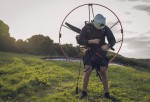
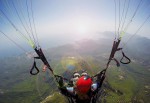
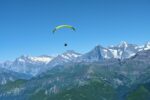

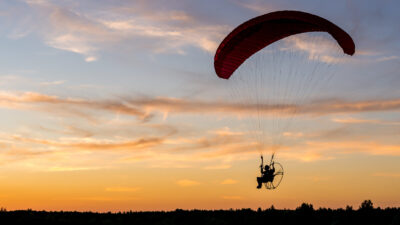
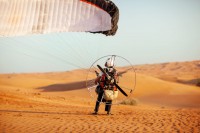



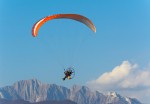

No comments posted yet
Comments are moderated for relevance and respectfulness.
Please keep the discussion focused on the topic of the article.